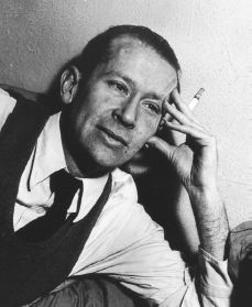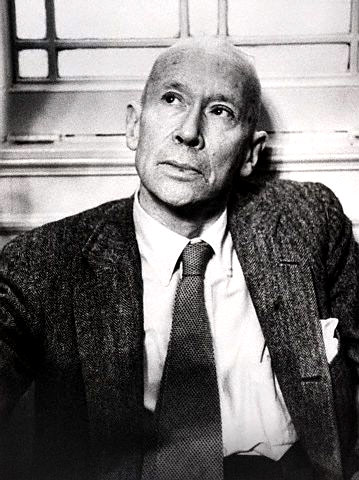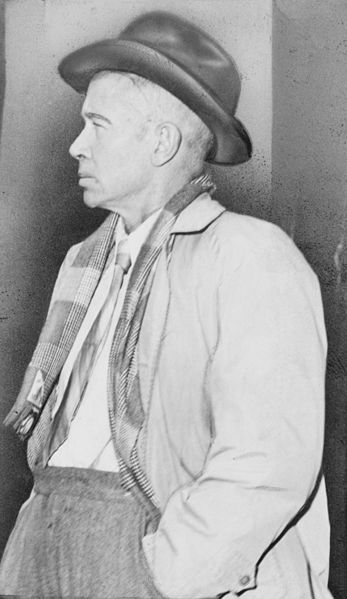<Back to Index>
- Sociologist Helmut Schelsky, 1912
- Poet Edward Estlin Cummings, 1894
- King of Spain Ferdinand VII, 1784
PAGE SPONSOR



Edward Estlin Cummings (October 14, 1894 – September 3, 1962), popularly known as E. E. Cummings, with the abbreviated form of his name often written by others in lowercase letters as e.e. cummings (in the style of some of his poems), was an American poet, painter, essayist, author, and playwright. His body of work encompasses approximately 2,900 poems, two autobiographical novels, four plays and several essays, as well as numerous drawings and paintings. He is remembered as a preeminent voice of 20th century poetry, as well as one of the most popular.
In 1917 Cummings enlisted in the Norton - Harjes Ambulance Corps, along with his college friend John Dos Passos. Due to an administrative mix-up, Cummings was not assigned to an ambulance for five weeks, during which time he stayed in Paris. He fell in love with the city, to which he would return throughout his life.
During their service in the ambulance corp, they had sent letters home that drew the attention of the military censors and preferred the company of French soldiers over fellow ambulance drivers. The two openly expressed anti war views; Cummings spoke of his lack of hatred for the Germans. On September 21, 1917, just five months after his belated assignment, he and a friend, William Slater Brown were arrested by the French military on suspicion of espionage and undesirable activities. They were held for 3½ months in a concentration camp at the Dépôt de Triage, in La Ferté - Macé, Orne, Normandy.
They were imprisoned with other detainees in a large room. Cummings' father failed to obtain his son's release through diplomatic channels and in December 1917 finally wrote a letter to President Wilson. Cummings was released on December 19, 1917, and Brown was released two months later. Cummings used his prison experience as the basis for his novel, The Enormous Room about which F. Scott Fitzgerald said, "Of all the work by young men who have sprung up since 1920 one book survives — The Enormous Room by e e cummings.... Those few who cause books to live have not been able to endure the thought of its mortality."
Cummings returned to the United States on New Year's Day 1918. Later in 1918 he was drafted into the army. He served in the 12th Division at Camp Devens, Massachusetts, until November 1918.
Cummings returned to Paris in 1921 and remained there for two years before returning to New York. During the rest of the 1920s and 1930s he returned to Paris a number of times, and traveled throughout Europe, meeting, among others, Pablo Picasso. In 1931 Cummings traveled to the Soviet Union and recounted his experiences in Eimi, published two years later. During these years Cummings also traveled to Northern Africa and Mexico and worked as an essayist and portrait artist for Vanity Fair magazine (1924 to 1927).
Cummings' papers are held at the Houghton Library at Harvard University and the Harry Ransom Center at the University of Texas at Austin.
In 1926, Cummings' father was killed in a car accident. Though severely injured, Cummings' mother survived. Cummings detailed the accident in the following passage from his i: six nonlectures series given at Harvard (as part of the Charles Eliot Norton Lectures) in 1952 – 1953:
... a locomotive cut the car in half, killing my father instantly. When two brakemen jumped from the halted train, they saw a woman standing – dazed but erect – beside a mangled machine; with blood spouting (as the older said to me) out of her head. One of her hands (the younger added) kept feeling her dress, as if trying to discover why it was wet. These men took my sixty-six year old mother by the arms and tried to lead her toward a nearby farmhouse; but she threw them off, strode straight to my father's body, and directed a group of scared spectators to cover him. When this had been done (and only then) she let them lead her away.
His father's death had a profound impact on Cummings, who entered a new period in his artistic life. Cummings began to focus on more important aspects of life in his poetry. He began this new period by paying homage to his father's memory in the poem "my father moved through dooms of love"
Born into a Unitarian family, Cummings exhibited transcendental leanings his entire life. As he grew in maturity and age, Cummings moved more toward an "I, Thou" relationship with God. His journals are replete with references to “le bon Dieu” as well as prayers for inspiration in his poetry and artwork (such as “Bon Dieu! may I some day do something truly great. amen.”). Cummings "also prayed for strength to be his essential self ('may I be I is the only prayer -- not may I be great or good or beautiful or wise or strong'), and for relief of spirit in times of depression ('almighty God! I thank thee for my soul; & may I never die spiritually into a mere mind through disease of loneliness')."
i thank You God for most this amazing
day:for the leaping greenly spirits of trees
and a blue true dream of sky; and for everything
which is natural which is infinite which is yes
Cummings was married briefly twice. Cummings' first marriage, to Elaine Orr, began as a love affair in 1918 while she was married to Scofield Thayer, one of Cummings' friends from Harvard. The affair produced a daughter, Nancy, born on December 20, 1919. Nancy was Cummings' only child. After divorcing Thayer, Elaine married Cummings on March 19, 1924. However, the marriage ended after two months and they were divorced less than nine months later. Elaine left Cummings for a wealthy Irish banker, moved to Ireland, and took Nancy with her. Under the terms of the divorce Cummings was granted custody of Nancy for three months each year, but Elaine refused to abide by the agreement. Cummings did not see his daughter again until 1946.
He married his second wife Anne Minnerly Barton on May 1, 1929, and they separated three years later in 1932. That same year, Anne obtained a Mexican divorce that was not officially recognized in the United States until August 1934.
The year Cummings and Anne separated, he met Marion Morehouse, a fashion model and photographer. Although it is not clear whether the two were ever legally married, Morehouse lived with Cummings in a common - law marriage until his death in 1962. Morehouse died on May 18, 1969, while living at 4 Patchin Place, Greenwich Village, New York City, where Cummings had resided since September 8, 1924.
A
liberal in his early youth, Cummings' disillusion upon his trip to the Soviet Union in 1931, documented in Eimi, led him to shift rightward on many political and social issues. Despite his radical and bohemian public image, he was a Republican and, later, an ardent supporter of Joseph McCarthy.
While his poetic forms and themes share an affinity with the romantic tradition, Cummings' work universally shows a particular idiosyncrasy of syntax, or way of arranging individual words into larger phrases and sentences. Many of his most striking poems do not involve any typographical or punctuation innovations at all, but purely syntactic ones.
As well as being influenced by notable modernists including Gertrude Stein and Ezra Pound, Cummings' early work drew upon the imagist experiments of Amy Lowell. Later, his visits to Paris exposed him to Dada and surrealism, which in turn permeated his work. Cummings also liked to incorporate imagery of nature and death into much of his poetry.
While some of his poetry is free verse (with no concern for rhyme or meter), many have a recognizable sonnet structure of 14 lines, with an intricate rhyme scheme. A number of his poems feature a typographically exuberant style, with words, parts of words, or punctuation symbols scattered across the page, often making little sense until read aloud, at which point the meaning and emotion become clear. Cummings, who was also a painter, understood the importance of presentation, and used typography to "paint a picture" with some of his poems.
The seeds of Cummings' unconventional style appear well established even in his earliest work. At age six, he wrote to his father:
FATHER DEAR. BE, YOUR FATHER - GOOD AND GOOD,
HE IS GOOD NOW, IT IS NOT GOOD TO SEE IT RAIN,
FATHER DEAR IS, IT, DEAR, NO FATHER DEAR,
LOVE, YOU DEAR,
ESTLIN.
Following his novel The Enormous Room, Cummings' first published work was a collection of poems entitled Tulips and Chimneys (1923). This work was the public's first encounter with his characteristic eccentric use of grammar and punctuation.
Some of Cummings' most famous poems do not involve much, if any, odd typography or punctuation, but still carry his unmistakable style, particularly in unusual and impressionistic word order. For example, "anyone lived in a pretty how town" begins:
anyone lived in a pretty how town
(with up so floating many bells down)
spring summer autumn winter
he sang his didn't he danced his did
Women and men (both little and small)
cared for anyone not at all
they sowed their isn't they reaped their same
sun moon stars rain
"why must itself up every of a park" begins as follows:
why must itself up every of a park
anus stick some quote statue unquote to
prove that a hero equals any jerk
who was afraid to dare to answer "no"?
Readers sometimes experience a jarring, incomprehensible effect with Cummings' work, as the poems do not act in accordance with the conventional combinatorial rules that generate typical English sentences (for example, "why must itself..." or "they sowed their isn't..."). His readings of Stein in the early part of the century probably served as a springboard to this aspect of his artistic development (in the same way that Robert Walser's work acted as a springboard for Franz Kafka). In some respects, Cummings' work is more stylistically continuous with Stein's than with any other poet or writer.
In addition, a number of Cummings' poems feature, in part or in whole, intentional misspellings, and several incorporate phonetic spellings intended to represent particular dialects. Cummings also made use of inventive formations of compound words, as in "in Just" which features words such as "mud-luscious", "puddle-wonderful", and "eddieandbill." This poem is part of a sequence of poems entitled Chansons Innocentes; it has many references comparing the "balloonman" to Pan, the mythical creature that is half goat and half man.
Many of Cummings' poems are satirical and address social issues, but have an equal or even stronger bias toward romanticism: time and again his poems celebrate love, sex, and the season of rebirth.
Cummings' talent extended to children's books, novels, and painting. A notable example of his versatility is an introduction he wrote for a collection of the comic strip Krazy Kat.
Examples of Cummings' unorthodox typographical style can be seen in his poem "The sky was candy luminous".
Mr. Cummings’s eccentric punctuation is, also, I believe, a symptom of his immaturity as an artist. It is not merely a question of an unconventional usage: unconventional punctuation may very well gain its effect… the really serious case against Mr. Cummings’s punctuation is that the results which it yields are ugly. His poems on the page are hideous.
— Edmund Wilson, from an essay entitled, Wallace Stevens and E.E. Cummings (1924)
During his lifetime, Cummings published four plays.
HIM, a three - act play, was first produced in 1928 by the Provincetown Players in New York City. The production was directed by James Light. The play's main characters are "Him", a playwright, and "Me", his girlfriend. Cummings said of the unorthodox play:
Relax and give the play a chance to strut its stuff — relax, stop wondering what it is all 'about' — like many strange and familiar things, Life included, this play isn't 'about,' it simply is. . . . Don't try to enjoy it, let it try to enjoy you. DON'T TRY TO UNDERSTAND IT, LET IT TRY TO UNDERSTAND YOU."
Anthropos, or the Future of Art is a short, one - act play that Cummings contributed to the anthology Whither, Whither or After Sex, What? A Symposium to End Symposium. The play consists of dialogue between Man, the main character, and three "infrahumans", or inferior beings. The word anthropos is the Greek word for "man", in the sense of "mankind".
Tom, A Ballet is a ballet based on Uncle Tom's Cabin. The ballet is detailed in a "synopsis" as well as descriptions of four "episodes", which were published by Cummings in 1935. It has never been performed.
Santa Claus: A Morality was
probably Cummings' most successful play. It is an allegorical Christmas
fantasy presented in one act of five scenes. The play was inspired by
his daughter Nancy, with whom he was reunited in 1946. It was first
published in the Harvard College magazine the Wake.
The play's main characters are Santa Claus, his family (Woman and
Child), Death, and Mob. At the outset of the play, Santa Claus' family
has disintegrated due to their lust for knowledge (Science). After a
series of events, however, Santa Claus' faith in love and his rejection
of the materialism and disappointment he associates with Science are
reaffirmed, and he is reunited with Woman and Child.
In 1952, his alma mater, Harvard, awarded Cummings an honorary seat as a guest professor. The Charles Eliot Norton Lectures he gave in 1952 and 1955 were later collected as i: six nonlectures.
Cummings spent the last decade of his life traveling, fulfilling speaking engagements, and spending time at his summer home, Joy Farm, in Silver Lake, New Hampshire.
He died of a stroke on September 3, 1962, at the age of 67 in North Conway, New Hampshire at the Memorial Hospital. His cremated remains were buried in Lot 748 Althaeas Path, in Section 6, Forest Hills Cemetery and Crematory in Boston. In 1969, his third wife, Marion Morehouse Cummings, died and was buried in an adjoining plot.
Cummings' publishers and others have sometimes echoed the unconventional orthography in his poetry by writing his name in lowercase and without periods. Cummings himself used both the lowercase and capitalized versions. According to his widow, he did not (as reported in the preface of one book) have his name legally changed to "e e cummings". On the contrary, he wrote to his French translator that he preferred the capitalized version ("may it not be tricksy"). One Cummings scholar believes that on the rare occasions that Cummings signed his name in all lowercase, he may have intended it as a gesture of humility, not as an indication that it was the preferred orthography for others to use.